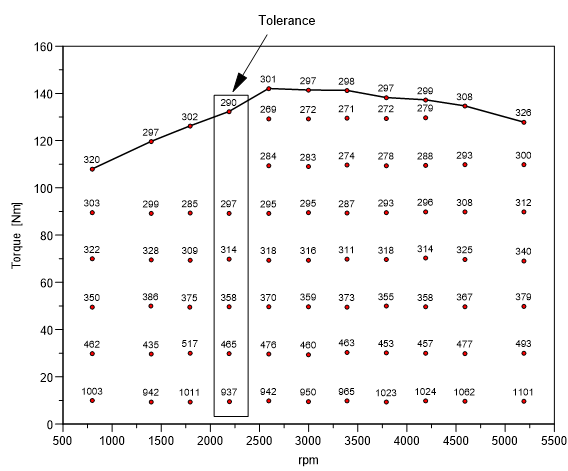auto_xyz_CreateHull¶
auto_xyz_CreateHull calculates a non convex data hull (Full Load Line, WOT) for the given 3D dataset if the data was measured at approx. constant x- (e.g. speed) or y-values.
- bool = auto_xyz_CreateHull(hData)
- bool = auto_xyz_CreateHull(hData, rsTolerance)
- bool = auto_xyz_CreateHull(hData, rsTolerance, nHullType)
- bool = auto_xyz_CreateHull(hData, rsTolerance, nHullType, nLabel)
- bool = auto_xyz_CreateHull(hData, rsTolerance, nHullType, nLabel, nDirection)
Return Value
If the function succeeds, the return value is TRUE (1); otherwise it is FALSE (0).
Parameters
- hData
The handle of a 3D dataset created with XYZCreate.
- rsTolerance
rsTolerence specifies the tolerance of the measured data (Default value = 0.5%)
- nHullType
nHullType specifies the hull type. (Default value = 1) Possible values are:
Value
Meaning
1
Full Load Line (North curve)
2
South curve
3
Complete hull
- nLabel
nLabel specifies the labeling of the data hull. (Default value = 1) Possible values are:
Value
Meaning
1
Label every point
2
Label every 2. point
3
Do not label
- nDirection
nDirection specifies if the data was measured at approx. constant x or y (Default value = 1)
Value
Meaning
1
x = Constant, (Full Load Line or WOT, tow curve)
2
y = Constant (West or East Curve)
Comment
If the original data was measured at constant x- or y-coordinates (e.g. rpm cross sections), the function can compute the non convex data hull. For cross section coordinates, a tolerance can be specified in a percentage of the range of the coordinates.
Example for speed (rpm) cross sections:
The function finds for each cross section value (eg. 1000, 1500, 2000, 2500) the
minimum and maximum value of the corresponding y coordinate. The maximum value
will create the WOT curve and the minimum value will create tow curve. If the
tolerance is 0.5 % and the speed range of the given engine is 1000 to 6000
rpm the absolute Tolerance is +/- 25 rpm.

See also
id-803056